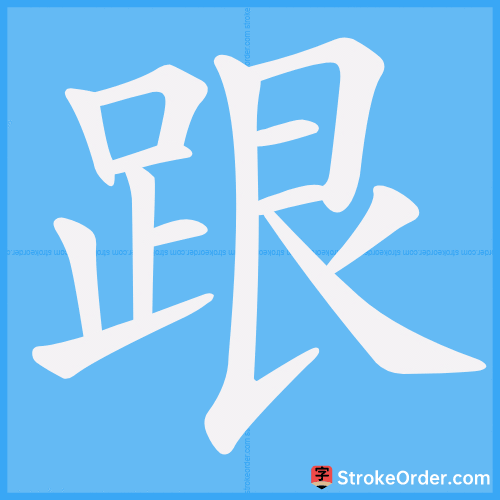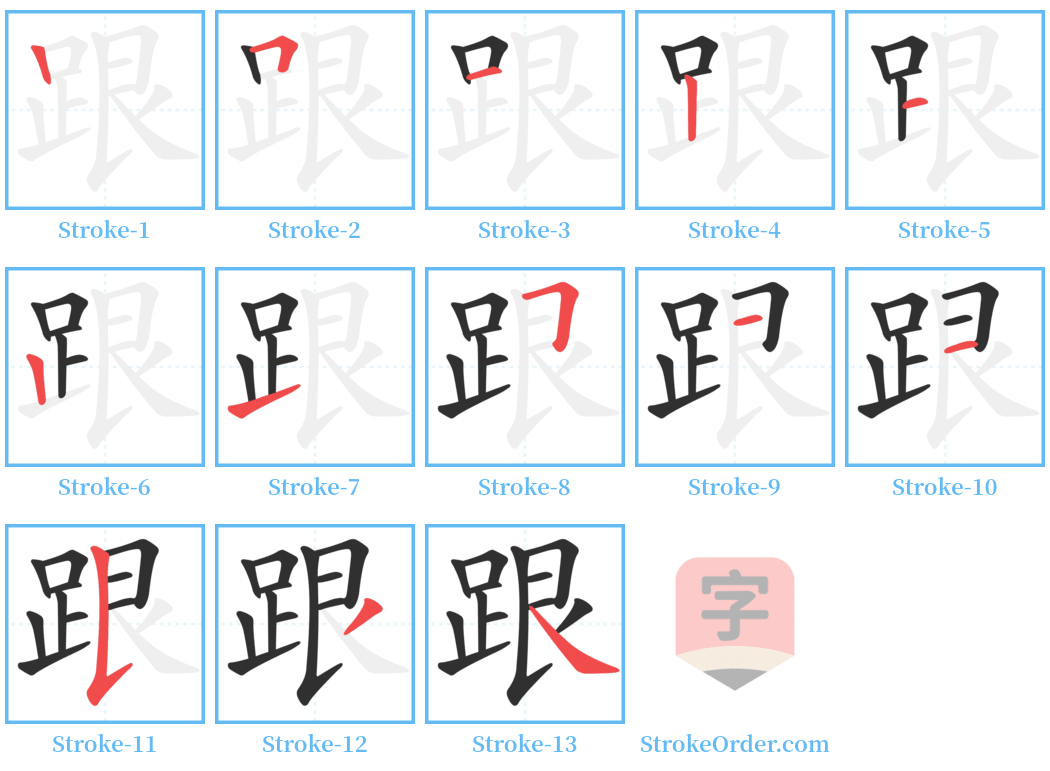跟 Stroke Order
Animated Stroke Order of 跟

Stroke Order Diagrams for 跟

Step-by-Step Handwriting Guide for 跟

Learn to Write Chinese Characters with Video Tutorials
Watch the video of writing the Chinese character "跟", learn the correct stroke order (笔顺) of the character "跟", and master the standard way of writing the character "跟".
Free Printable Handwriting Practice with Stroke Order: 跟
Printable Writing Practice Worksheet of "跟" in Portrait Orientation (Tian Zi Ge)

Printable Writing Practice Worksheet of "跟" in Landscape Orientation (Tian Zi Ge)

Information of 跟
Pinyin
gēn
Radical
足
Strokes
13 strokes
Usage
★★★★★
Definition
to follow / to go with / heel / with / and
跟 [gēn]
1. 名词 (Noun)
- 脚的后部,踵。 (The back part of the foot, heel.)
- 鞋袜的后部。 (The back part of shoes and socks.)
- 器官的基底部分。亦指物体的底部或后部。 (The base part of an organ; also refers to the bottom or rear part of an object.)
- 例: 脚后跟 (heel of the foot); 高跟鞋 (high-heeled shoes); 崖跟 (bottom of a cliff).
2. 动词 (Verb)
- 随在后面,紧接着。 (To follow closely.)
- 比;及;抵。 (To compare with; to reach.)
- 穿着(鞋),趿。 (To put on [shoes].)
- 旧时指女子嫁人。 (In the past, referred to a woman getting married.)
- 例: 跟我来 (follow me); 小偷一直跟着他 (the thief kept following him).
3. 介词 (Preposition)
- 和,同。 (With; together.)
- 表示与某事物有无联系。 (Indicates a relation or connection with something.)
- 向,对。 (To; towards.)
- 表示处所,相当于“从”。 (Indicates a location, equivalent to "from".)
- 例: 他跟我借了一支铅笔 (he borrowed a pencil from me); 他要跟你谈一谈 (he wants to talk to you).
4. 联合关系 (Conjunction)
- 表示联合关系,相当于和、与。 (Indicates a joint relationship; equivalent to "and".)
- 例: 桌子放着笔跟纸 (the table has a pen and paper); 孩子跟妇女 (children and women).
5. 比较使用 (Comparison)
- 用作介词时,口语中常用“跟”,书面语现在倾向于用“同”。 (In spoken language, "跟" is often used as a preposition, while written language currently tends to use "同".)
- 用作连词时,一般倾向于用“和”,较少用“跟”。 (As a conjunction, "和" is generally preferred, with "跟" being less common.)
- “与”多用于书面,尤其多用在书名、标题中。 (The character "与" is often used in writing, especially in titles and book names.)
Input Method for 跟
Pinyin
gen1
Wubi
khve|khvy
Cangjie
rmav
Zhengma
jixo
Four Corner
67132
Unicode
U+8ddf